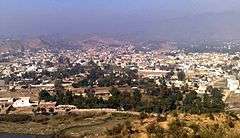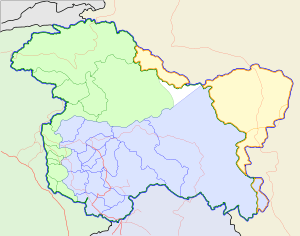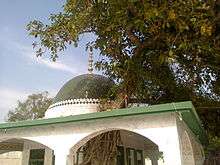Bhimber
Bhimber (Urdu: بھمبر) is the capital of Bhimber District, in the Pakistan-administered territory of Azad Kashmir. The town is on the border between Kashmir and Pakistan, about 29 mi (47 km) by road southeast of Mirpur.[2]
Bhimber بھمبر | |
|---|---|
 | |
 Bhimber  Bhimber | |
| Coordinates: 32°58′50″N 74°04′10″E | |
| Country | Pakistan |
| Territory | Azad Kashmir |
| District | Bhimber District |
| Established | 7th century AD |
| Population (2017)[1] | |
| • Total | 27,636 |
| Time zone | UTC+5 (PST) |
| Postal code | 10040 |
| Dialling code | 0092-05828 |
| Website | Official Website |
History
Bhimber was the capital of the Chibhal dynasty, which lasted from 1400 to 1856. Katoch.[3][4][5]
Bhimber lies on the route that was followed by the Mughal Emperors for their frequent visits to the Kashmir Valley. It is also known as "Baab-e-Kashmir" (Door to Kashmir) because of its importance and geographical location, which was ideal for the Mughal Emperors to use to enter Kashmir. Therefore, the Mughals used Bhimber as a staging point for their journey to Srinagar. The Mughal Emperor Jahangir discussed Bhimber in his book Tuzk-e-Jahangiri.[6]
Modern history
In the 19th century, Chibhal came under the Sikh Empire of the Maharaja Ranjit Singh. Around 1822, along with Poonch, it was granted as a jagir (feudal land grant) to Raja Dhian Singh of the Dogra dynasty, Gulab Singh's brother. After the death of Maharaja Ranjit Singh, the Sikh court fell into disunity, and Dhian Singh was murdered in a court intrigue. Subsequently, the princely state of Jammu and Kashmir was formed under the suzerainty of the British Empire, and these territories were transferred to Jammu and Kashmir. The jagir given to Dhian Singh was respected, however, and Dhian Singh's sons Moti Singh and Jawahir Singh were retained as its Rajas.[7][8][9]
In 1852, the brothers Jawahir and Moti Singh quarreled, and the Punjab Board of Revenue awarded a settlement. Moti Singh was awarded the Poonch district, and Jawahir Singh was awarded Bhimber, Mirpur and Kotli.[10][11] In 1859, Jawahir Singh was accused of 'treacherous conspiracy' by Maharaja Ranbir Singh (r. 1857–1885), who succeeded Gulab Singh. The British agreed with the assessment and forced Jawahir Singh to exile in Ambala. Ranbir Singh paid Jawahir Singh an annual stipend of Rs. 100,000 until his death, and appropriated his territory afterwards because Jawahir Singh had no heirs.[12]
The appropriated territory was organised as the Bhimber district (wazarat) in 1860. In the decade preceding 1911, the district headquarters was shifted to Mirpur and it came to be called the Mirpur district.[13][14] Bhimber remained a tehsil headquarters until 1947. It had a Hindu majority population, mostly consisting of Mahajans.[15]
Geography and climate

Bhimber is a valley. Its hot, dry climate and other geographical conditions closely resemble those of Gujrat, the adjoining district of Pakistan.
Its climate is classified as warm and temperate. Summers have a good deal of rainfall; winters have very little. This location is classified as Cwa by Köppen and Geiger. The average annual temperature is 23.6 °C (74.5 °F) with a yearly average rainfall of 974 mm (38.3 in). July and August are the wettest months. Temperatures are highest in June.[16]
Landmarks

Baghsar Fort is an ancient Mughal fort in the Samahni Valley overlooking Baghsar Lake.[17] Sarai Saadabad is located near Bandala in the Samahni Valley and was used as a staging camp during Mughal Era for the caravans moving from Lahore to Kashmir. Also of note is the Tomb of Sufi saint Baba Shadi Shaheed.
Notable people
- Manzoor Mirza, economist
- Ghulam Rasul Raja, Pakistan Army officer
References
- "Statistical Year Book 2019" (PDF). Statistics Azad Jammu and Kashmir. Retrieved 20 April 2020.
- Google (1 February 2020). "Bhimber" (Map). Google Maps. Google. Retrieved 1 February 2020.
- Gulabnama of Diwan Kirpa Ram: A History of Maharaja Gulab Singh of Jammu & Kashmir, page 41
- History of the Punjab Hill States by Hutchison and Vogel, reprinted edition, 2 volumes in 1 Chapter XXIV. 1933 AD
- The Ancient Geography of India by Alexander Cunningham page 134 1871
- Government of Azad Jammu & Kashmir Website. "Jahangir discussed Bhimber in his book Tuzk-e-Jahangiri". Archived from the original on 28 September 2011. Retrieved 8 December 2011.
- Panikkar, Gulab Singh 1930, pp. 121–123.
- Brahma Singh, History of Jammu and Kashmir Rifles 2010.
- Satinder Singh, Raja Gulab Singh's Role 1971, pp. 52–53.
- Snedden, Kashmir: The Unwritten History 2013, p. 232.
- Panikkar, Gulab Singh 1930, p. 123.
- Snedden, Kashmir: The Unwritten History 2013, p. 233.
- "A peep into Bhimber". dailyexcelsior.com. 6 November 2016. Retrieved 7 May 2019.
- India. Census Commissioner (1912), Census of India, 1911, Superintendent of government printing, India
- Saraf, Kashmiris Fight for Freedom, Volume 2 2015, p. 238.
- "Climate Bhimber". en.climate-data.org. Retrieved 7 May 2019.
- Ashgar Ahmad (1986). Pakistan Tourism Directory, 86. Holiday Weekly. p. 170.
Bibliography
- Bamzai, P. N. K. (1994), Culture and Political History of Kashmir, M.D. Publications Pvt. Ltd., ISBN 978-81-85880-31-0
- Effendi, Col. M. Y. (2007), Punjab Cavalry: Evolution, Role, Organisation and Tactical Doctrine 11 Cavalry, Frontier Force, 1849-1971, Karachi: Oxford University Press, ISBN 978-0-19-547203-5
- Huttenback, Robert A. (1961), "Gulab Singh and the Creation of the Dogra State of Jammu, Kashmir, and Ladakh" (PDF), The Journal of Asian Studies, 20 (4): 477–488, doi:10.2307/2049956, archived from the original (PDF) on 15 August 2016, retrieved 23 November 2018
- Panikkar, K. M. (1930). Gulab Singh. London: Martin Hopkinson Ltd.
- Raghavan, Srinath (2010), War and Peace in Modern India, Palgrave Macmillan, pp. 101–, ISBN 978-1-137-00737-7
- Rai, Mridu (2004), Hindu Rulers, Muslim Subjects: Islam, Rights, and the History of Kashmir, C. Hurst & Co, ISBN 1850656614
- Schofield, Victoria (2003) [First published in 2000], Kashmir in Conflict, London and New York: I. B. Taurus & Co, ISBN 1860648983
- Singh, Bawa Satinder (1971), "Raja Gulab Singh's Role in the First Anglo-Sikh War", Modern Asian Studies, 5 (1): 35–59, doi:10.1017/s0026749x00002845, JSTOR 311654
- Singh, K. Brahma (2010) [first published Lancer International 1990], History of Jammu and Kashmir Rifles, 1820-1956: The State Force Background (PDF), brahmasingh.co.nf, ISBN 978-81-7062-091-4, archived from the original (PDF) on 6 March 2016, retrieved 23 November 2018
- Snedden, Christopher (2013) [first published as The Untold Story of the People of Azad Kashmir, 2012], Kashmir: The Unwritten History, HarperCollins India, ISBN 9350298988
- Zaheer, Hasan (1998), The Times and Trial of the Rawalpindi Conspiracy, 1951: The First Coup Attempt in Pakistan, Oxford University Press, ISBN 978-0-19-577892-2